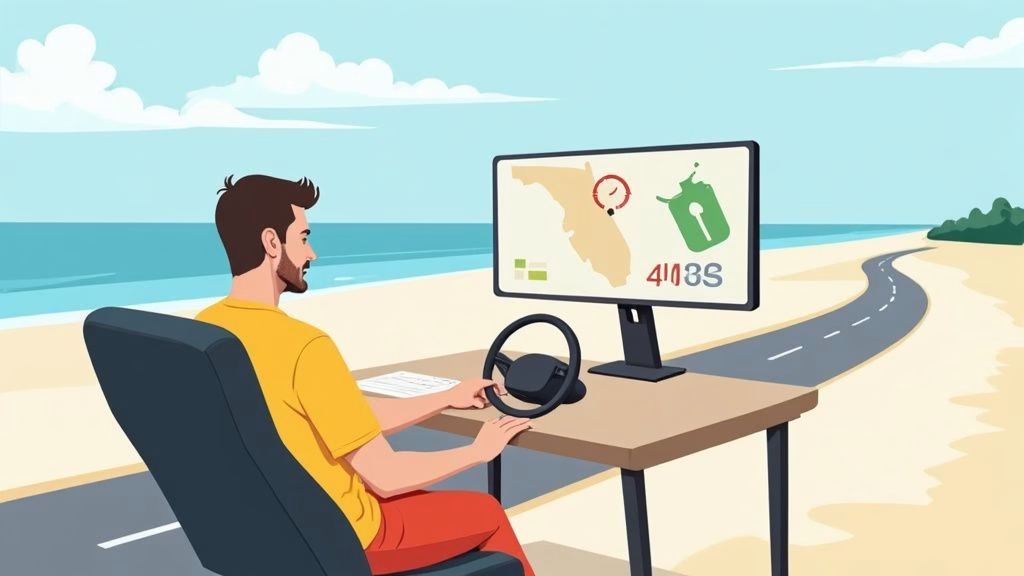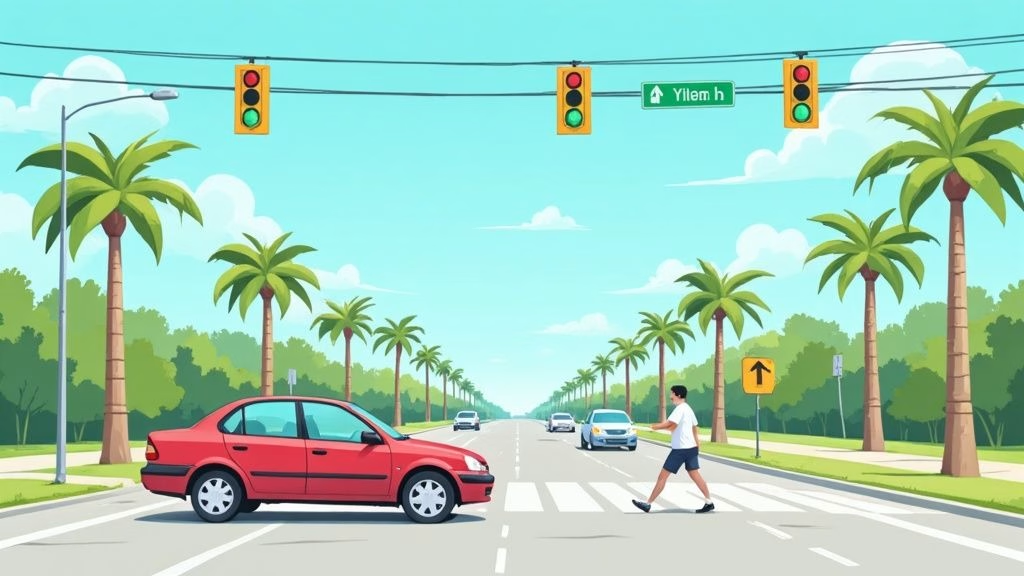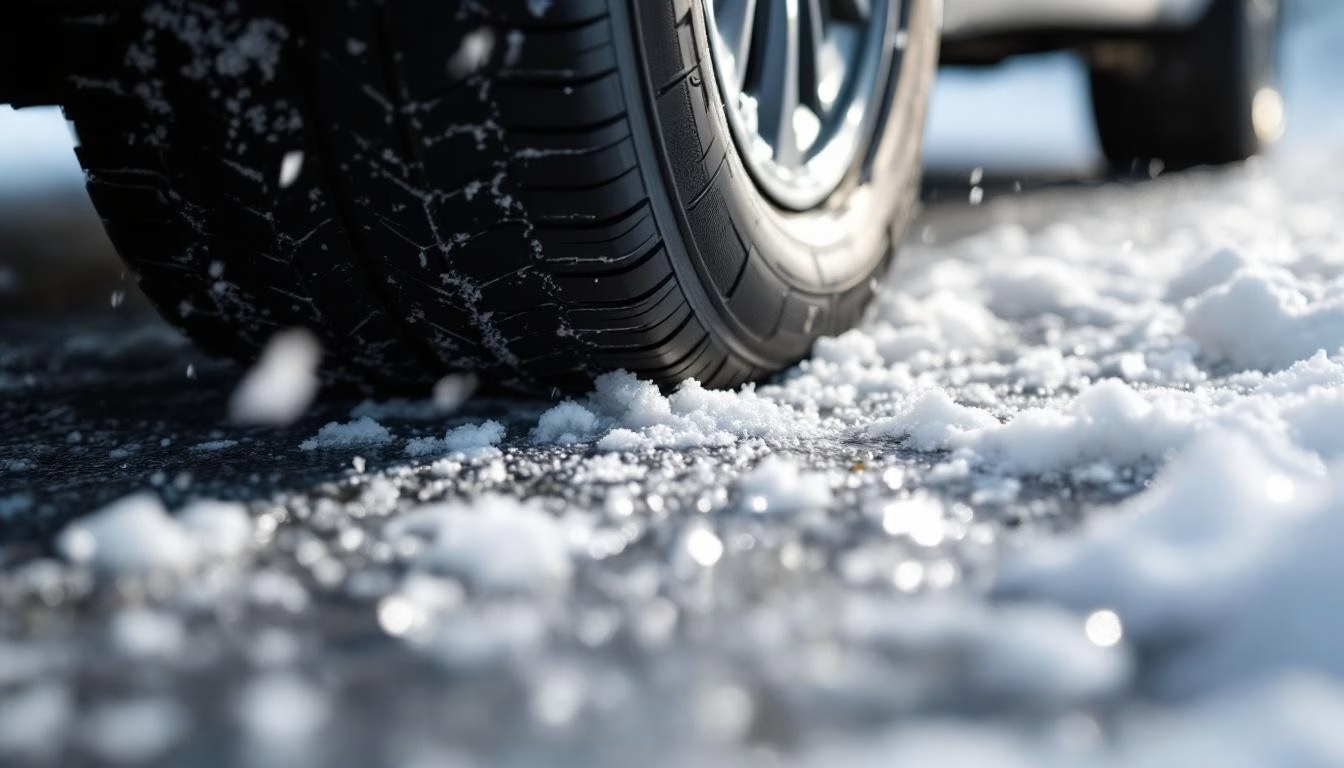Defensive driving goes beyond basic traffic rules. It’s a proactive approach that puts safety first through awareness, preparation, and smart decision-making behind the wheel.
At floridanewdriver.com, we see how understanding what defensive driving means can dramatically reduce accident risks. The techniques save lives and money on insurance premiums while making roads safer for everyone.
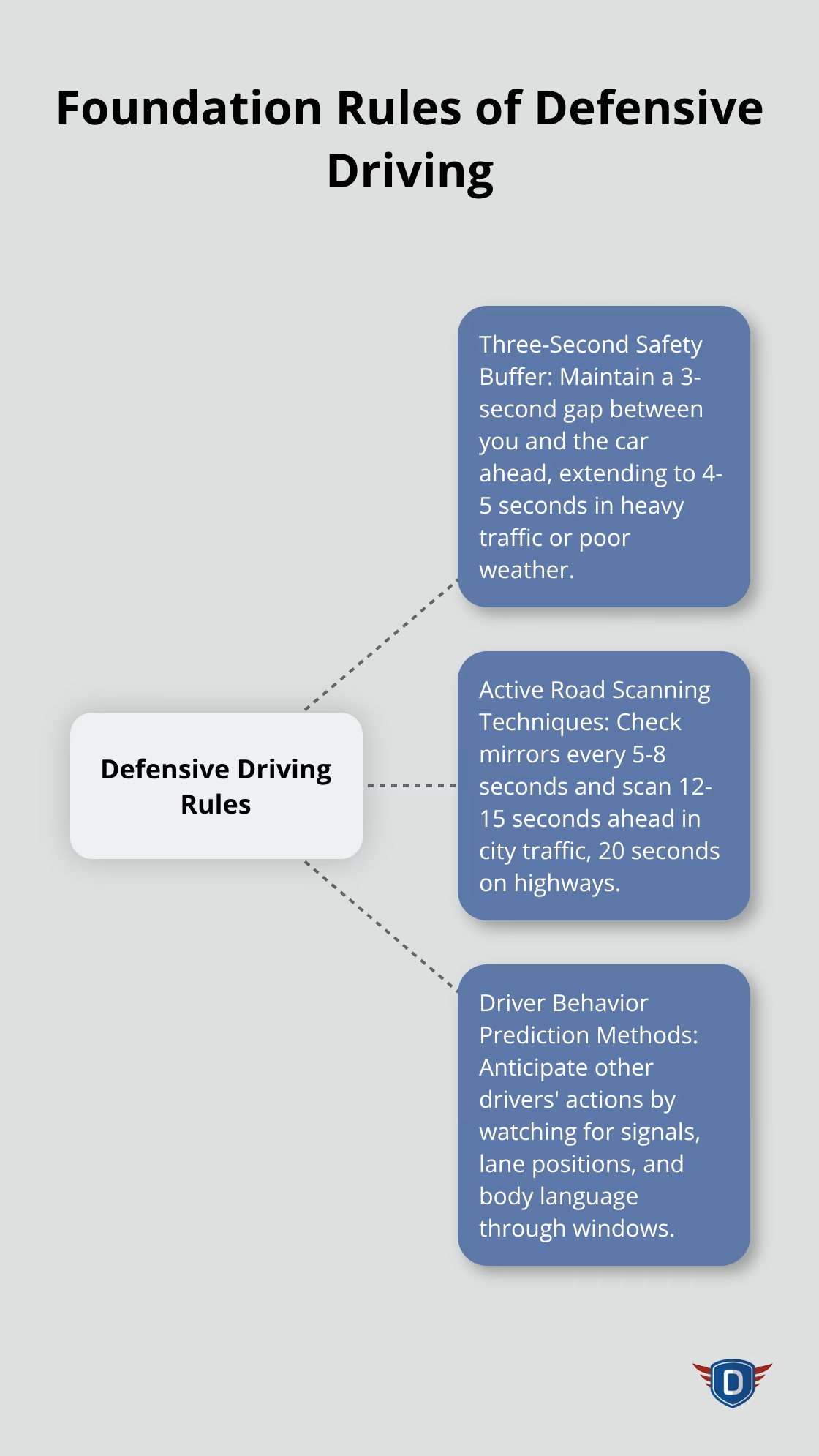
What Are the Three Foundation Rules of Defensive Driving?
The Three-Second Safety Buffer
Most drivers follow too closely and create the perfect setup for rear-end collisions. The National Highway Traffic Safety Administration has conducted comprehensive analyses of rear-end crashes and near-crashes to understand their causes and characteristics. The three-second rule works in normal conditions, but smart drivers extend this to four or five seconds in heavy traffic or poor weather. Count the seconds between when the car ahead passes a fixed object and when you reach the same spot. This simple technique provides reaction time that saves lives and prevents the most common type of crash on American roads.
Active Road Scanning Techniques
Constant scanning ahead separates defensive drivers from reactive ones. Professional drivers check their mirrors every five to eight seconds and scan the road 12 to 15 seconds ahead in city traffic (extending to 20 seconds on highways). Watch for brake lights in traffic ahead, cars that change lanes without signals, and pedestrians near crosswalks. The AAA Foundation for Traffic Safety emphasizes that drivers who actively scan their environment reduce accident risk through early hazard identification before emergencies develop.
Driver Behavior Prediction Methods
Anticipation beats reaction every time. Watch for cars with turn signals that don’t match their lane position, vehicles that weave slightly between lanes, or drivers who look down at their phones. Research evaluates general driving behavior in relation to actual crash and near-crash involvement during real-world driving situations. Look for head movements, wheel position, and body language through windows. Aggressive drivers often telegraph their moves through rapid lane changes or tailgating behavior. Position your vehicle to avoid their path before they make dangerous moves that put everyone at risk.
These three foundation rules work together to create a comprehensive safety system. However, mastering specific techniques takes these principles from theory into practice on real roads.
How Do You Master Essential Defensive Driving Techniques?
Mirror Systems and Visual Scanning Patterns
Professional drivers understand that information becomes outdated fast at highway speeds, making regular mirror checks essential for safe navigation. Monitoring systems can alert drivers of vehicles in blind spots, typically warning of another vehicle’s presence via symbol, sound or vibration. Set up your mirrors to minimize blind spots – your side mirrors should show just a sliver of your car’s body, not the entire side panel.
Check your rearview mirror first, then left side, then right side in a continuous rotation. Scan ahead 12-15 seconds in city traffic and 20-25 seconds on highways. This means you look about one city block ahead in town or a quarter-mile on interstates. Watch for brake lights three or four cars ahead, not just the vehicle directly in front of you.
Speed Control Strategies
Speed management goes beyond posted limits. The Insurance Information Institute data shows that drivers who travel too fast for conditions cause 31% more crashes than those who exceed speed limits. Reduce speed by 10-15 mph in rain, 20-25 mph in snow, and maintain steady throttle through curves instead of braking mid-turn.
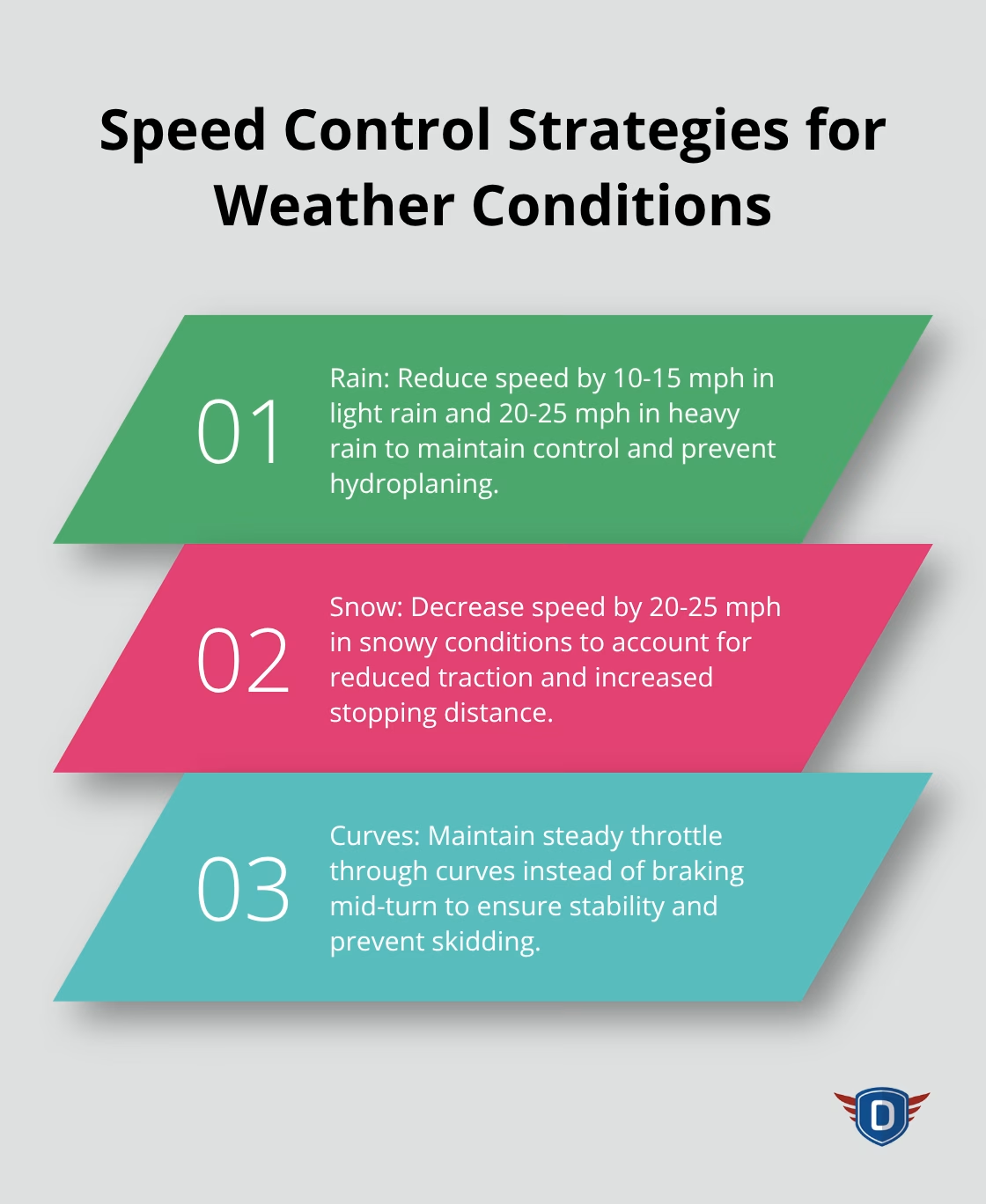
Match traffic speed before you enter the highway – acceleration lanes exist for building speed, not for slow merges that force other drivers to brake. Leave a four-second gap when you change lanes, and always signal for at least 100 feet before you move (this gives other drivers adequate warning time).
Lane Positioning Techniques
Position your vehicle in the center-left portion of your lane on multi-lane roads to maximize escape routes and visibility around larger vehicles. This strategic placement helps you see around trucks and SUVs while maintaining options to move left or right when hazards appear.
The Federal Highway Administration studies confirm that proper lane positioning reduces side-swipe collisions by 18% compared to drivers who hug lane edges or drift between markings. Drivers who maintain consistent lane position also report less fatigue during long trips (steady positioning requires less constant steering correction).
These techniques work best when you combine them with awareness of the specific hazards that create the most dangerous situations on today’s roads.
How Do You Handle High-Risk Road Situations
Neutralizing Aggressive and Distracted Drivers
Aggressive drivers create dangerous situations on the road, while distracted drivers cause 2,841 deaths annually. When you spot an aggressive driver who weaves through traffic or tailgates, create space immediately. Move to the right lane and let them pass – never engage through eye contact or gestures that escalate confrontation.
Distracted drivers show telltale signs: they drift between lanes, react slowly to traffic signals, and maintain inconsistent speeds. Position your vehicle where you can escape quickly if they drift into your lane. The most dangerous combination occurs when distracted drivers become aggressive after near-misses. Watch for drivers who suddenly accelerate after they look up from their phones or who make aggressive lane changes while they still hold devices.
Maintain a four-second distance behind these drivers and avoid positions alongside them at traffic lights.
Weather-Related Speed and Distance Adjustments
Weather conditions demand immediate speed and distance adjustments that most drivers ignore. Reduce speed by 10 mph in light rain, 20 mph in heavy rain, and 25 mph in snow conditions. The Federal Highway Administration data shows that wet pavement contributes to 75% of weather-related crashes because drivers maintain dry-weather speeds on dangerous surfaces.
Hydroplaning increases in wet climates and on roads with minimal drainage, particularly when tire tread depth falls below 4/32 inches. Ice conditions require even more dramatic speed reductions – black ice forms when temperatures hover near freezing and creates nearly invisible hazards that catch drivers completely off-guard.
Construction Zone Navigation Strategies
Construction zones kill 762 people annually, with 85% of fatalities involving motorists rather than workers. Merge early when you see construction signs – last-second lane changes create chain-reaction crashes that trap multiple vehicles. Construction zones often have reduced visibility and changed traffic patterns that catch drivers unprepared.
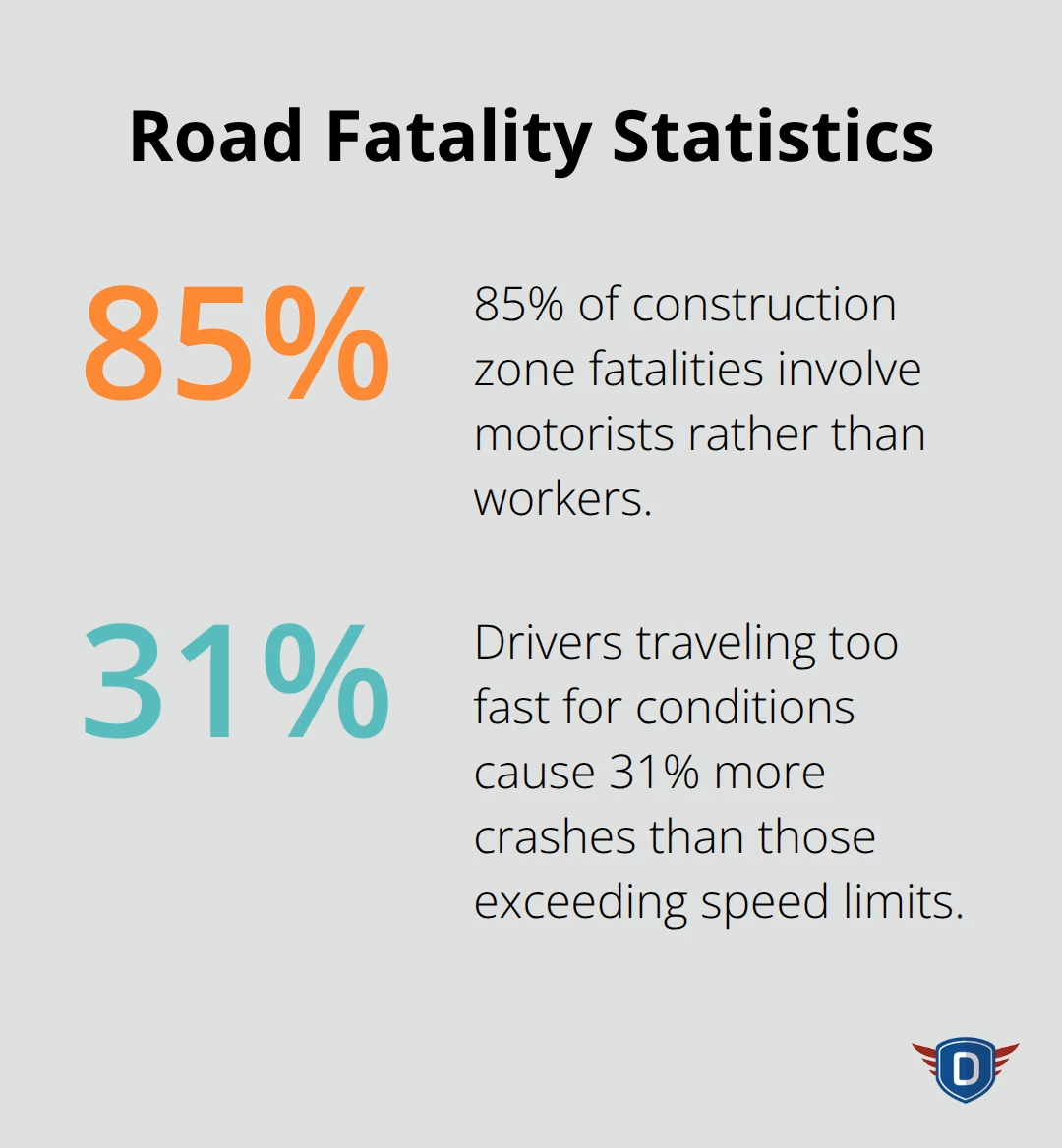
Workers operate heavy machinery close to traffic lanes, and concrete barriers eliminate escape routes that exist on normal highways. Reduce speed by 15-20 mph below posted construction limits, even when no workers are visible. Equipment and materials can shift unexpectedly, and lane widths often narrow to just 11 feet (compared to standard 12-foot lanes).
Emergency Vehicle Response Protocols
Emergency vehicles present unique challenges that test your reaction speed and decision-making abilities. Move over completely to the far lane when possible, or reduce speed by 20 mph if you cannot change lanes safely. Ambulances, fire trucks, and police vehicles often approach at high speeds with limited visibility around curves or hills.
Pull to the right shoulder when emergency vehicles approach from behind – never stop in traffic lanes or attempt to outrun emergency responders. Some states impose fines up to $500 for failure to move over, but the real risk comes from emergency vehicles that must swerve around stopped traffic at dangerous speeds.
Final Thoughts
Defensive drivers understand what defensive driving means and apply these principles to transform every trip into a safer experience. Statistics show that defensive techniques reduce crash risks by 30% and prevent approximately 1.5 million accidents each year. These numbers translate into real savings through lower insurance premiums and reduced vehicle maintenance costs.
The three-second rule, active road scans, and anticipation strategies create multiple layers of protection that work together. Weather adjustments and proper responses to aggressive drivers add another level of safety that standard driver education often overlooks. Construction zones and emergency vehicle encounters test these skills in high-pressure situations where split-second decisions matter most (and where mistakes prove costly).
Insurance companies recognize defensive driver value through premium discounts that last three years after course completion. The 10% reduction applies to both auto and motorcycle coverage, which makes professional training a smart financial investment beyond safety benefits. We at floridanewdriver.com help students master defensive techniques that prevent accidents and build confidence behind the wheel.



